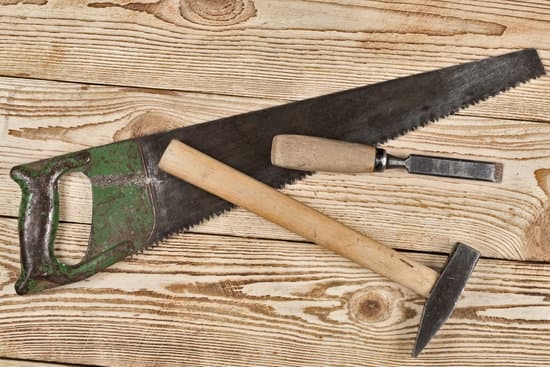Refinishing woodwork is a crucial step in maintaining the aesthetics and longevity of your furniture, cabinets, or any wooden surfaces in your home. In this article, we will discuss how to quickly refinish woodwork, emphasizing the importance of not only reviving the appearance of wood but also protecting it from wear and tear over time.
By refinishing woodwork promptly, you can potentially save time and money by preventing further damage that may require more extensive repairs or even replacement. The benefits of quick refinishing also include enhancing the overall appeal of your living space and adding value to your property. With the right tools and techniques, you can achieve professional-looking results in no time.
Whether you are a seasoned DIY enthusiast or a novice looking to tackle a home improvement project, understanding the refinishing process can be empowering. From gathering materials to prepping the woodwork and applying the stain, each step plays a crucial role in achieving a successful outcome. In the following sections, we will delve into detailed instructions and tips on how to efficiently refinish woodwork for impressive results.
Gathering Materials
Refinishing woodwork can breathe new life into your furniture and home decor, giving it a fresh and updated look. With the right tools and products, you can quickly refinish woodwork to achieve professional results. Gathering the necessary materials is the first step in this process, ensuring that you have everything you need for a successful refinishing project.
To quickly refinish woodwork, you will need the following tools and products:
- Sanding block or power sander
- Sandpaper (varying grits)
- Clean rags or cloths
- Wood stain of your choice
- Brushes or cloths for applying stain
- Protective finish (polyurethane, varnish, etc.)
- Painters tape or plastic sheeting to protect surrounding areas
- Gloves and safety goggles
Having these materials on hand will make the refinishing process run smoothly and efficiently. Be sure to choose high-quality products to ensure a professional finish on your woodwork.
Before starting the refinishing process, double-check that you have all the necessary tools and products listed above. This preparation step will save you time and prevent interruptions during the project. Once you have everything gathered, you’ll be ready to move on to preparing the workspace and prepping the woodwork for refinishing.
Preparing the Workspace
When it comes to refinishing woodwork, preparing the workspace is crucial for achieving a successful outcome. A clean and organized area not only makes the process more efficient but also ensures that the final result is of high quality. Here are some tips on how to create the ideal workspace for refinishing woodwork.
Clearing the Area
Before you begin refinishing your woodwork, it’s important to clear the area of any clutter or obstacles. Make sure to remove any furniture, decorations, or other items that could get in the way of your work. This will give you plenty of space to move around freely and access all parts of the woodwork without any restrictions.
Covering Surfaces
To protect your floors and other surfaces from potential spills or damage during the refinishing process, lay down drop cloths or plastic sheeting. This will help catch any drips or splatters and make cleanup much easier once you’re done. Additionally, consider using masking tape to protect walls or nearby objects from accidental stains or marks.
Organizing Tools and Materials
Set up a designated area for all your tools and materials needed for refinishing woodwork. Keep everything within easy reach to avoid wasting time searching for items during the process. Consider using labeled containers or shelves to keep everything organized and easily accessible. Having everything in its place will streamline the refinishing process and make it more efficient overall.
By following these tips for preparing your workspace, you can create an environment that sets you up for success when refinishing woodwork. A clean and organized area will not only make the process smoother but also help you achieve professional-looking results quickly and effectively. Now that your workspace is ready, you’re one step closer to transforming your woodwork into a beautiful finish that enhances the overall look of your space.
Prepping the Woodwork
Woodwork refinishing involves a crucial step of prepping the woodwork properly before applying any stain or finish. This step ensures that the final result is smooth, even, and long-lasting. In this section, we will discuss a step-by-step guide on how to clean and sand the woodwork effectively to achieve the best results. By following these guidelines, you can quickly refinish your woodwork and give it a fresh new look.
Cleaning the Woodwork
Before starting the sanding process, it is essential to thoroughly clean the woodwork to remove any dirt, dust, or grime that may affect the refinishing process. Use a mild detergent solution with warm water and a soft cloth to wipe down the surface of the woodwork.
Make sure to pay attention to any crevices or intricate details in the woodwork where dust may accumulate. Once you have cleaned the surface, allow it to dry completely before proceeding to the next step.
Sanding the Woodwork
Sanding is an important step in refinishing woodwork as it helps to smooth out any imperfections in the surface and prepare it for staining. Start by using coarse-grit sandpaper (around 80-100 grit) to remove any old finish or rough spots on the wood. Then gradually work your way up to finer grit sandpaper (150-220 grit) to achieve a smooth and even surface.
Make sure to sand with the grain of the wood for best results. Once you have finished sanding, use a tack cloth or vacuum cleaner to remove any dust particles from the surface before proceeding with staining.
Protective Gear
It is important to wear proper protective gear such as goggles and a mask when sanding woodwork to protect yourself from dust and debris. Additionally, make sure to work in a well-ventilated area to prevent inhaling harmful fumes from stains or finishes. By following these steps on how to quickly refinish woodwork through proper cleaning and sanding techniques, you can achieve professional-looking results in no time.
Choosing the Right Stain
Wood stains are an essential part of the refinishing process, as they add color and beauty to the woodwork while also protecting it from damage. There are various types of wood stains available in the market, each with its unique characteristics and benefits. When choosing the right stain for your project, consider factors such as the type of wood, desired color, and level of protection needed.
One popular type of wood stain is oil-based stain, which penetrates deep into the wood fibers to enhance the natural grain and texture. Oil-based stains are known for their durability and long-lasting finish. On the other hand, water-based stains offer quick drying times and low odor, making them a popular choice for indoor projects where ventilation may be limited.
When selecting a stain color, it’s important to test samples on a small inconspicuous area of the woodwork to ensure that it achieves the desired shade. Keep in mind that different wood species may react differently to the same stain, so testing is crucial before proceeding with the entire project. Additionally, consider applying a pre-stain conditioner to prevent blotching and achieve a more uniform finish.
Applying the Stain
Refinishing woodwork can be a rewarding project that adds beauty and value to your home. Applying the stain is a crucial step in this process, as it not only enhances the natural beauty of the wood but also provides protection against wear and tear. In this section, we will provide you with detailed instructions on how to apply the stain evenly and effectively for professional-looking results.
Before applying the stain, make sure that the woodwork has been properly cleaned and sanded according to the prepping steps outlined earlier in this guide. Once your woodwork is ready, follow these steps to ensure a smooth application of the stain:
- Begin by stirring the stain thoroughly to ensure an even consistency.
- Using a clean cloth or brush, apply a thin, even coat of stain in the direction of the wood grain.
- Allow the first coat to dry completely before applying additional coats for a deeper color.
It is important to work in small sections at a time to avoid overlap marks and achieve a consistent finish across the entire surface. Take your time during this process and be mindful of any drips or excess stain that may need to be wiped away promptly.
By following these tips on how to apply the stain evenly and effectively, you can achieve professional-quality results when refinishing your woodwork. Next, we will discuss adding finishing touches to protect and enhance the newly stained woodwork for long-lasting beauty.
Finishing Touches
Woodwork refinishing involves more than just applying a fresh coat of stain. One crucial step in the process is adding a protective finish to the woodwork, ensuring that your hard work lasts for years to come. A protective finish not only enhances the appearance of the wood but also shields it from damage caused by moisture, heat, and everyday wear and tear.
When it comes to choosing a protective finish for your woodwork, there are several options to consider. Polyurethane, varnish, shellac, and lacquer are popular choices known for their durability and ability to protect the wood from scratches and stains. Before deciding on a finish, consider factors such as the type of wood you are working with, the desired level of sheen, and the amount of use the woodwork will endure.
Once you have selected the appropriate protective finish for your project, it is essential to apply it correctly. Start by thoroughly stirring the finish to ensure an even consistency. Using a high-quality brush or applicator pad, apply a thin coat of finish in smooth, even strokes following the grain of the wood.
Allow each coat to dry completely before applying additional coats as needed. Remember that multiple thin coats are preferable to one heavy coat as they provide better protection without creating an uneven or blotchy surface.
| Protective Finish Options | Characteristics |
|---|---|
| Polyurethane | Durable and scratch-resistant |
| Varnish | Provides excellent protection against moisture |
| Shellac | Enhances natural grain patterns in wood |
| Lacquer | Dries quickly and creates a glossy finish |
By following these tips on how to add a protective finish to your freshly refinished woodwork, you can ensure that your efforts stand the test of time. With proper care and maintenance, your woodwork will continue to look beautiful and remain protected for years to come. Don’t overlook this important final step in the refinishing process – it could make all the difference in preserving your stunning workmanship.
Clean Up and Final Thoughts
Refinishing woodwork can be a rewarding project that enhances the look and durability of your furniture or fixtures. Doing it quickly not only saves time but also allows you to enjoy the results sooner. By following the steps outlined in this guide on how to quickly refinish woodwork, you can achieve professional-looking results without spending countless hours on the task.
After gathering all the necessary materials and preparing your workspace, it’s essential to clean up properly after refinishing woodwork. This not only maintains a tidy work environment but also ensures that your tools are well-maintained for future projects. Remember to dispose of any used materials responsibly and store your equipment in a safe place.
In conclusion, learning how to quickly refinish woodwork is a valuable skill that can save you time and money while preserving the beauty of your wooden pieces. By following the steps outlined in this guide, from prepping the woodwork to choosing the right stain and applying a protective finish, you can achieve professional-quality results in no time. So why wait? Start refinishing your woodwork today and enjoy the satisfaction of revitalizing your furniture with your own hands.
Frequently Asked Questions
How to Easily Refinish Wood Furniture?
Refinishing wood furniture can be done easily with some basic steps. Start by removing any existing finish using a stripping agent. Sand the surface to smooth out imperfections and prepare it for a new finish. Apply a coat of stain or paint to achieve the desired look, followed by a protective topcoat.
How Can I Restore Old Wood Without Sanding?
Restoring old wood without sanding is possible by using a wood cleaner and conditioner to remove dirt and grime from the surface. After cleaning, apply a wood restorer product to revitalize the wood’s appearance and bring back its natural luster. Finish with a quality wood polish to protect and enhance the finish.
How Do You Refresh Old Woodwork?
Refreshing old woodwork involves first cleaning the surface with a mild detergent or cleaner to remove dirt and residue. For scratches or dents, use wood filler to repair imperfections before sanding the area smooth. Apply a fresh coat of paint or stain to update the look and protect the woodwork for years to come.

Hi everyone! I’m a woodworker and blogger, and this is my woodworking blog. In my blog, I share tips and tricks for woodworkers of all skill levels, as well as project ideas that you can try yourself.





